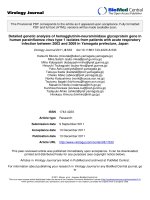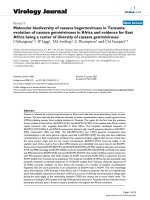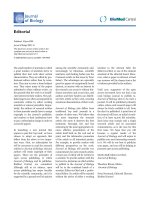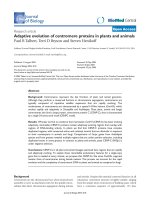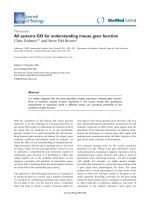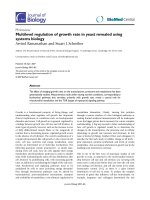Báo cáo sinh học : " Is genetic diversity really higher in large populations" ppsx
Bạn đang xem bản rút gọn của tài liệu. Xem và tải ngay bản đầy đủ của tài liệu tại đây (149.26 KB, 3 trang )
Minireview
IIss ggeenneettiicc ddiivveerrssiittyy rreeaallllyy hhiigghheerr iinn llaarrggee ppooppuullaattiioonnss??
Hans Ellegren
Address: Department of Evolutionary Biology, Uppsala University, Norbyvägen 18D, SE-752 36 Uppsala, Sweden.
Email:
Students of population genetics learn from their textbooks
that levels of genetic diversity are determined by the rate of
mutation (the number of new mutations per nucleotide site
and generation) and the number of reproducing individuals
in the population. The latter is usually termed the effective
population size (N
e
), and is almost always less than the
total population size. These determinants are intuitive, as a
higher rate of mutation creates more new genetic variants
and a large population is less sensitive to random loss of
variants by genetic drift. It therefore came as a surprise when
it was reported a few years ago that genetic variability in
mitochondrial DNA (mtDNA), one of the most commonly
used markers in evolutionary and population genetic
analysis, did not seem to correlate with population size
when analyzed over broad taxonomic groups. For example,
levels of polymorphism were found to be similar for
invertebrates and vertebrates, despite the fact that the
former typically have much larger population sizes than the
latter [1]. It was argued that the non-recombining nature of
mtDNA makes its diversity prone to be shaped by natural
selection for new and beneficial variants - eradicating, or at
least reducing, a correlation between population size and
genetic variability. In addition, strong purifying selection
against deleterious mtDNA mutations in the female
germline could further homogenize levels of diversity
(background selection) [2]. The observation that the
fixation rate of non-synonymous substitutions in mtDNA
correlates positively with N
e
in broad evolutionary compari-
sons [1] supports the idea that neutral variants frequently
hitchhike along with positively selected alleles in the
mtDNA genome when N
e
is large.
The report by Bazin and colleagues [1] sparked off debate,
as did a study suggesting that mtDNA of birds would be
particularly susceptible to selection, as it is in complete
linkage disequilibrium with the maternally inherited W sex
chromosome [3]. Birds have female heterogamety (males
ZZ, females ZW), meaning that mothers transmit both
mtDNA and the W chromosome to their daughters
(Figure 1). Like the mammalian Y chromosome, the avian
W chromosome only recombines in a small pseudoauto-
somal region. Theoretically, this would mean that selection
in the non-recombining part of the W chromosome would
also affect mtDNA, and vice versa. The W chromosome itself
has very low within-species variability, at least in chickens,
testifying to a strong role for selection [4]. Does this mean
that selection on avian mtDNA masks the expected signal of
N
e
on diversity and that diversity estimates in avian mtDNA
are thus especially poor predictors of effective population
size, potentially reducing the value of this marker in, for
AAbbssttrraacctt
Analyses of mitochondrial DNA (mtDNA) have challenged the concept that genetic diversity
within populations is governed by effective population size and mutation rate. A recent study
in
BMC Evolutionary Biology
shows that variation in the rate of mutation rather than in
population size is the main explanation for variations in mtDNA diversity observed among
bird species.
Journal of Biology
2009,
88::
41
Published: 21 April 2009
Journal of Biology
2009,
88::
41 (doi:10.1186/jbiol135)
The electronic version of this article is the complete one and can be
found online at />© 2009 BioMed Central Ltd
example, biodiversity studies [5,6]? Rather, is the rate of
mutation the main factor regulating mtDNA diversity in
birds? Answers to these questions are now brought closer by
a recent study by Nabholz et al. published in BMC
Evolutionary Biology [7], which compares mtDNA divergence
and diversity estimates for a large number of bird species
with various types of life history, including different popu-
lation structures and population sizes.
VVaarriiaattiioonn iinn aavviiaann mmuuttaattiioonn rraatteess
As the rate of mutation is difficult to measure directly, the
number of substitutions that have accumulated during a
certain time period in an evolutionary lineage is often taken
as a proxy for the mutation rate. Nabholz et al. [7] gathered
mtDNA sequence data from more than 1,000 bird species,
available in GenBank, and used divergence estimates from
these together with fossil calibration points to estimate
substitution rates, and thereby, indirectly, mutation rates.
The new data indicate that there is more than an order of
magnitude variation in the mtDNA substitution rate among
different bird lineages, challenging the ‘2%-rule’, which is
yet another question under debate [8]. That idea stipulates
that the mtDNA mutation rate follows a ‘molecular clock’
corresponding to 2% sequence divergence every million
years of evolution (0.02 substitutions per site per million
years). Nabholz et al. [7] find that substitution rate is
positively correlated with metabolic rate and negatively
correlated with longevity, two life-history traits previously
suggested to explain deviations from a molecular clock.
The metabolic hypothesis posits that the production of
mutagenic free radicals - reactive oxygen species (ROS), by-
products of respiration - increases with increasing rates of
respiration, and so, therefore, does the rate of mutation. The
longevity hypothesis proposes that long-lived organisms
have evolved decreased rates of mtDNA mutation as an
adaptation to reduce the deleterious effects of somatic
mutations accumulating during their lifetime. Birds have
higher metabolic rates than mammals, but when Nabholz et
al. [7] compared the rates of mtDNA evolution in both
groups, they found that avian mtDNA mutates at a signifi-
cantly lower rate than that of mammals, especially when
body size is regressed out of the analysis. They therefore
favor life span as the main determinant of avian mtDNA
mutation rates.
TThhee ddeetteerrmmiinnaannttss ooff aavviiaann mmttDDNNAA ddiivveerrssiittyy
The significant heterogeneity in substitution rates observed
in avian mtDNA from different species means that there is
scope for variation in mutation rate to also explain
variations in within-species mtDNA diversity. Indeed,
Nabholz et al. [7] find that substitution rate and level of
polymorphism are positively related. However, two proxys
for N
e
(body size and current population census size) are
not. These observations support the idea that avian mtDNA
diversity is primarily due to the extent of mutational input,
not to the effective population size, corroborating the
previous claim based on data from other organisms [1].
Previously, the same authors had analyzed mammalian
mtDNA for a correlation between the amount of adaptive
evolution and N
e
but no correlation was found [9], which is
at odds with the general idea that the efficiency of selection
relates to life history. It may be that the relatively small
populations typical of mammals mean that genetic drift
plays a big role in producing mtDNA diversity but, none-
theless, N
e
does not seem to correlate with mtDNA diversity
in mammals [9]. Perhaps past demographic changes or the
influence of mutation rate variation mask a signal from
present-day N
e
. In their new study, Nabholz et al. [7] do not
find a strong footprint of selection in avian mtDNA, similar
to the situation in mammals [7]. Mutation rate variation
therefore remains a vital explanation for variation in
mtDNA diversity of birds.
Does this mean that it is time to rewrite those parts of
population genetics textbooks that deal with predictions of
41.2
Journal of Biology
2009, Volume 8, Article 41 Ellegren />Journal of Biology
2009,
88::
41
FFiigguurree 11
Schematic illustration of the inheritance pattern of mtDNA and sex
chromosomes in birds and other female heterogametic systems.
Z
W
67% 33%
100%
Male
germline
Female
germline
mt
Z
W
67% 33%
100%
Male
germline
Female
germline
mt
polymorphism levels? Clearly, as far as mtDNA is con-
cerned, there does seem to be a need for revision. However,
a cautionary note should be sounded to acknowledge the
difficulties in properly estimating N
e
by proxys such as body
size or longevity. At present, it would be premature to state
that the role of selection in shaping levels of mtDNA
diversity is more pronounced in birds or other female
heterogametic taxa than in male heterogametic systems,
such as mammals.
Even if levels of diversity in mtDNA do not give us an
unbiased picture of the effective size of avian populations,
the use of mtDNA as a genetic marker is still warranted for
other purposes, such as studies of phylogenetics and phylo-
geography. New high-throughput sequencing technologies
might, however, lead to a shift in focus from population
genetic studies based on mtDNA to population genomic
approaches based on nuclear DNA, to estimate effective
population size. Large-scale analyses of nuclear DNA can
provide better and more direct estimates of N
e
, thereby
allowing more careful tests of the relationship between life
history and population genetic and molecular evolutionary
parameters.
RReeffeerreenncceess
1. Bazin E, Glemin S, Galtier N:
PPooppuullaattiioonn ssiizzee ddooeess nnoott iinnfflluueennccee
mmiittoocchhoonnddrriiaall ggeenneettiicc ddiivveerrssiittyy iinn aanniimmaallss
Science
2006,
331122::
570-
572.
2. Stewart JB, Freyer C, Elson JL, Larsson NG:
PPuurriiffyyiinngg sseelleeccttiioonn ooff
mmttDDNNAA aanndd iittss iimmpplliiccaattiioonnss ffoorr uunnddeerrssttaannddiinngg eevvoolluuttiioonn aanndd mmiittoo
cchhoonnddrriiaall ddiisseeaassee
Nat Rev Genet
2008, [Epub ahead of print].
3. Berlin S, Tomaras D, Charlesworth B:
LLooww mmiittoocchhoonnddrriiaall vvaarriiaabbiill
iittyy iinn bbiirrddss mmaayy iinnddiiccaattee HHiillll RRoobbeerrttssoonn eeffffeeccttss oonn tthhee WW cchhrroommoo
ssoommee
Heredity
2007,
9999::
389-396.
4. Berlin S, Ellegren H:
CChhiicckkeenn WW:: aa ggeenneettiiccaallllyy uunniiffoorrmm cchhrroommoo
ssoommee iinn aa hhiigghhllyy vvaarriiaabbllee ggeennoommee
Proc Natl Acad Sci USA
2004,
110011::
15967-15969.
5. Ballard JWO, Whitlock MC:
TThhee iinnccoommpplleettee nnaattuurraall hhiissttoorryy ooff
mmiittoocchhoonnddrriiaa
Mol Ecol
2004,
1133::
729-744.
6. Hurst GDD, Jiggins FM:
PPrroobblleemmss wwiitthh mmiittoocchhoonnddrriiaall DDNNAA aass aa
mmaarrkkeerr iinn ppooppuullaattiioonn,, pphhyyllooggeeooggrraapphhiicc aanndd pphhyyllooggeenneettiicc ssttuuddiieess::
tthhee eeffffeeccttss ooff iinnhheerriitteedd ssyymmbbiioonnttss
Proc Biol Sci
2005,
227722::
1525-
1534.
7. Nabholz B, Glémin S, Galtier N:
TThhee eerrrraattiicc mmiittoocchhoonnddrriiaall cclloocckk::
vvaarriiaattiioonn ooff mmuuttaattiioonn rraattee,, nnoott ppooppuullaattiioonn ssiizzee,, aaffffeeccttss mmttDDNNAA
ddiivveerrssiittyy aaccrroossss bbiirrddss aanndd mmaammmmaallss
.
BMC Evol Biol
2009,
99::
54.
8. Pereira SL, Baker AJ:
AA mmiittooggeennoommiicc ttiimmeessccaallee ffoorr bbiirrddss ddeetteeccttss
vvaarriiaabbllee pphhyyllooggeenneettiicc rraatteess ooff mmoolleeccuullaarr eevvoolluuttiioonn aanndd rreeffuutteess tthhee
ssttaannddaarrdd mmoolleeccuullaarr cclloocckk
Mol Biol Evol
2006,
2233::
1731-1740.
9. Nabholz B, Mauffrey JF, Bazin E, Galtier N, Glemin S:
DDeetteerrmmiinnaa
ttiioonn ooff mmiittoocchhoonnddrriiaall ggeenneettiicc ddiivveerrssiittyy iinn mmaammmmaallss
Genetics
2008,
117788::
351-361.
/>Journal of Biology
2009, Volume 8, Article 41 Ellegren 41.3
Journal of Biology
2009,
88::
41


